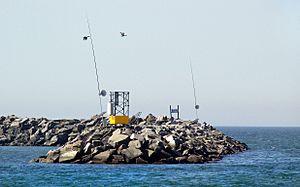Susan Philipsz facts for kids
Quick facts for kids
Susan Philipsz
|
|
|---|---|
| Born |
Susan Mary Philipsz
1965 (age 59–60) Maryhill, Glasgow, Scotland
|
| Nationality | Scottish |
| Education | Duncan of Jordanstone College of Art University of Ulster |
| Spouse(s) | Eoghan McTigue |
| Awards | Turner Prize |
| Patron(s) | MoMA PS1 |
Susan Mary Philipsz, born in 1965, is a Scottish artist. She is famous for her amazing sound installations. She won the important Turner Prize in 2010. Susan started as a sculptor, but now she creates art using sound. She records herself singing songs without any instruments, which is called a cappella. These recordings are then played in art galleries or other public places. Susan Philipsz lives and works in Berlin, Germany.
Contents
Early Life and Art School
Susan Philipsz was born in Maryhill, a part of Glasgow, Scotland. She grew up with five brothers and sisters. Her father was partly from Burma and lived there as a child. His family's life was changed by war, and he moved to the UK when he was in his twenties.
When Susan was young, she sang in her local Catholic church choir with her sisters. This is where she learned to sing in harmony.
From 1989 to 1993, she studied sculpture at Duncan of Jordanstone College of Art in Dundee, Scotland. After that, she earned a master's degree in Fine Arts from the University of Ulster in Northern Ireland, studying there from 1993 to 1994.
From 2000 to 2001, she was a special artist-in-residence at MoMA PS1, a famous art center in New York City. She also led Catalyst Arts in Belfast for several years. Susan Philipsz is married to the Irish photographer Eoghan McTigue.
How Susan Philipsz Creates Art

Susan Philipsz mainly makes sound installations. She uses recordings of her own voice. These recordings are played in specific places. Her goal is to help people connect more deeply with their surroundings. She also wants to inspire them to think about things in a thoughtful way.
Even though Susan sings in many of her artworks, it's important that her voice is not professionally trained. She has an average, natural voice. She also cannot read or write sheet music. Susan explained that a human voice, especially an untrained one, can bring back strong memories. She believes that if she had gone to music school, her art would be very different today.
Famous Sound Art Pieces
- "Filter" (1998): This work included her versions of songs by bands like Nirvana and Radiohead. It was played in unusual places, like a bus station and a supermarket.
- "The Internationale" (1999): For this piece, she sang a solo, a cappella version of the famous revolutionary song.
- "The Dead" (2000): In this work, she sings an old Irish song called "The Lass of Aughrim."
- "Sunset Song" (2003): She sings both the male and female parts of a 19th-century American folk song, "Banks of the Ohio." The volume of the music changes depending on how much light there is.
- "You are not alone" (2009): This piece used a vibraphone and was made for the Radcliffe Observatory in Oxford, England.
- "Lowlands" (2010): The Glasgow International Festival asked her to create this piece. It featured three versions of a 16th-century Scottish song called "Lowlands Away." These were played under three bridges over the River Clyde in Glasgow. "Lowlands" was later shown at Tate Britain, where it helped her win the 2010 Turner Prize.
- "Study for Strings" (2012): This artwork was created for documenta, a big art show. It was based on an orchestral piece from 1943. That original music was composed in a concentration camp for musicians there. For her recording, Philipsz only used the parts for one cello and one viola. This left quiet spaces between the notes, making the piece very moving.
Art Exhibitions and Recognition
Susan Philipsz has shown her art in many important exhibitions around the world. These include the Melbourne International Biennial 1999, Manifesta 3 in Slovenia in 2000, and the Biennale of Sydney in 2008. She also had a solo show at the Institute of Contemporary Arts in 2008.
In 2010, she was asked to create a special artwork for the rotunda at the Solomon R. Guggenheim Museum in New York City.
In 2011, the Museum of Contemporary Art, Chicago asked her to create a sound installation. This piece, called We Shall Be All, was inspired by Chicago's labor history. It focused on events like the 1886 Haymarket Affair and the Industrial Workers of the World (IWW). As part of her exhibition at the MCA, she also showed her work The Internationale in the museum's main hall. She also presented her 2002 work Pledge at the Jane Addams Hull House Museum.
In 2013, Philipsz's work was part of Soundings: A Contemporary Score. This was the first major exhibition of sound art at the Museum of Modern Art in New York City. In 2016, her work, "Part File Score" was shown at the Hirshhorn Museum.
Awards and Honors
In 2003, Susan Philipsz was nominated for the Beck's Futures award. In 2010, she won the famous Turner Prize. This award was for her sound installation that featured her singing three versions of a Scottish song. She received the £25,000 prize at a ceremony at Tate Britain. She was also nominated for a Glenfiddich Spirit of Scotland Award that same year.
In 2014, she was given the title Officer of the Order of the British Empire (OBE). This honor was for her contributions to British art.
See Also
- Sound art
- List of sound artists

